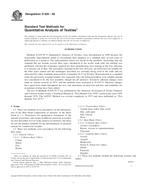Potrebujeme váš súhlas na využitie jednotlivých dát, aby sa vám okrem iného mohli ukazovať informácie týkajúce sa vašich záujmov. Súhlas udelíte kliknutím na tlačidlo „OK“.
ASTM D629-08
Standard Test Methods for Quantitative Analysis of Textiles
Automaticky preložený názov:
Štandardné skúšobné metódy pre kvantitatívnu analýzu textilu
NORMA vydaná dňa 1.8.2008
Informácie o norme:
Označenie normy: ASTM D629-08
Poznámka: NEPLATNÁ
Dátum vydania normy: 1.8.2008
Kód tovaru: NS-34539
Počet strán: 22
Približná hmotnosť: 66 g (0.15 libier)
Krajina: Americká technická norma
Kategória: Technické normy ASTM
Anotácia textu normy ASTM D629-08 :
Keywords:
Acceptance criteria/testing--textile fabrics/fibers, Animal fibers, Bast and leaf fibers/products, Cellulose and cellulose derivatives, Cellulose fiber, Chemical properties--textiles, Composition analysis--textiles, Cotton fibers, Cross-section measurement/properties, Dissection, Extractable matter content--textile fabrics/fibers, Fiber composition, Flax fiber and products, Hemp fibers/products, Man-made textile fibers, Mechanical dissection, Microscopic examination--textiles
Doplňujúce informácie
| Significance and Use | ||||||||||||||||||||||||||||||||||
|
Test Methods D 629 for the determination of quantitative analysis of textiles may be used for acceptance testing of commercial shipments but caution is advised since information on between-laboratory precision is lacking. Comparative tests as directed in 5.1.1 or by Table D 1909 may be advisable. In case of a dispute arising from differences in reported test results using Test Methods D 629 for acceptance testing of commercial shipments, the purchaser and the supplier should conduct comparative tests to determine if there is a statistical bias between their laboratories. Competent statistical assistance is recommended for the investigation of bias. As a minimum, the two parties should take a group of test specimens which are as homogeneous as possible and which are from a lot of material of the type in question. The test specimen should then be randomly assigned in equal numbers to each laboratory for testing. The average results from the two laboratories should be compared using Student's t-test and an acceptable probability level chosen by the two parties before the testing began. If a bias is found, either its cause must be found and corrected or the purchaser and supplier must agree to interpret future test results in the light of the known bias. The effects of the various reagents used in the chemical methods on the residual fibers in a blend depend upon the history of the fibers and, unless otherwise stated, are generally too small or too uncertain to warrant the application of correction factors. Fiber composition is generally expressed either on the oven-dry mass of the original sample or the oven-dry mass of the clean fiber after the removal of nonfibrous materials. If nonfibrous materials are not first removed from the textile before the fiber analysis is carried out, or if the treatments described in Section 8 are incapable of removing them, any such materials present will increase the percentage of the fiber constituent with which they are removed during the analysis, assuming they are soluble in the solvent used. The analytical methods are intended primarily for the separation of binary mixtures of fibers. These procedures may also be used for the analysis of mixtures containing more than two types of fibers by selecting the best combination of methods to use (Table 1). Since a sequence of solvents on a given fiber may produce different results than the expected results from a single solvent, it is advisable to determine the results of such sequential effects when testing multiple fiber blends. It is sometimes more convenient to separate mechanically the yarns in a textile which are of similar types, and then use the appropriate chemical method to analyze each of the components. Table 2 shows the solubilities of the various fibers in different chemical reagents. |
||||||||||||||||||||||||||||||||||
| 1. Scope | ||||||||||||||||||||||||||||||||||
|
1.1 These test methods cover procedures for the determination of the fiber blend composition of mixtures of the fibers listed in 1.2. Procedures for quantitative estimation of the amount of moisture and certain nonfibrous materials in textiles are also described, for use in the analysis of mixtures, but these are not the primary methods for the determination of moisture content for commercial weights. |
||||||||||||||||||||||||||||||||||
| 2. Referenced Documents | ||||||||||||||||||||||||||||||||||
|
Odporúčame:
EviZak - všetky zákony vrátane ich evidencie na jednom mieste
Poskytovanie aktuálnych informácií o legislatívnych predpisoch vyhlásených v Zbierke zákonov od roku 1945.
Aktualizácia 2x v mesiaci !
Chcete vedieť viac informácii ? Pozrite sa na túto stránku.




 Cookies
Cookies
